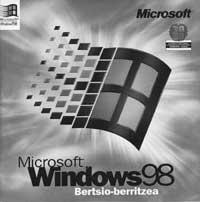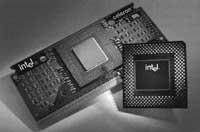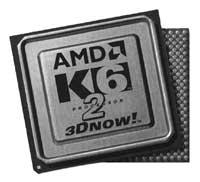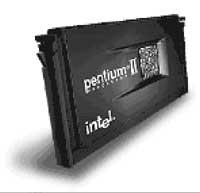Unknown between Windows 98 and Pentium III
1999/05/01 Waliño, Josu - Elhuyar Fundazioa Iturria: Elhuyar aldizkaria

Everyone follows their path, but there is a great similarity between Microsoft and Intels. Although the first aims at software development, the second focuses on hardware development. That is the main difference. The similarities are as follows: both have legal problems for monopoly reasons and both prevail in their working environment. Both have launched their new product in the last year and both have been born surrounded by controversy. In the case of Windows 98 nobody knew exactly what was coming, why we needed this, when Microsoft has already clearly opted for Windows 2000, which will be after Windows NT. The birth of the Pentium III has been different: it is clear that its speed is higher, since the computers that circulate at 450 and 500 MHz are on the street and it has been announced that it works at 600 MHz shortly. This chip has a higher number of commands (about 70), especially for 3D graphics and multimedia. So far, it is a good processor and there is no doubt that it will be a major advance in the processor market.
But Intel, like Microsoft, wanted to leave the mark of its pride and gave a number of its own to each chip, opening the way to debate. It seems that this number can be read from the Internet, thus losing the privacy of the user. In Intel's words, it is only a system to increase security in e-commerce, but several groups have considered this system an Internet control system. Surveys on this topic can already be consulted online and Intel appears as a loser in all of them. It is clear that netizens want to navigate in the anonymity tray. Finally an intermediate solution has been found: the chip will carry the number but without activating it. The user will activate it using soft if desired.
AMD preparing K7
AMD and Cyrix processors began to take hold when Intel released Celero and Mendocino chips. The latter were as fast as Intel's Pentium II and much cheaper. As a result, they have had their presence in the market and, at least, they have succeeded until we give no importance to Nike or Adidas. Now the AMD K6-3 processor is about to be fired and according to the tests performed, the BMD at a speed of 450 MHz is faster than the Pentium II at the same speed and certainly more economical. In parallel, a K7 processor is being developed that will compete directly with Pentium III and will be on the market soon.
Windows 98 and Pentium III

As discussed earlier, Intel Pentium III processors have another problem. The truth is that it is not a processor with problems, but Windows 98. It seems that this system does not know Pentium III and uses them as if they were Pentium II. Consequently, this new Windows does not correctly use all the options offered by the processor. As Microsoft and Intel have indicated, this is not a problem, as only advanced Pentium III users will use it for the moment and they usually use more reliable systems such as Windows NT. However, the next Windows 98 service pack that will take to the streets in autumn, would repair this bug.
Next year, Windows 2000 will be released, which will be the next version of NT (already delayed from summer 99 to February 2000), replacing Windows 95 and 98. This is OK, because NT offers reliability that your siblings do not offer and it is not based like the rest on DOS. What have we achieved then with Windows 98? We don't know, but at least Microsoft has a lot of money. There is not much to conclude, but you have to read what the president of General Motors said about Windows.
Windows in the car
At the latest ComDex computer fair, Bill Gates made the following statements when comparing the computer industry with the car industry:
“If General Motors (GM) technology developed the same as the computer industry, cars of 25 dollars and a gallon (4,546 liters) with gasoline per 1,000 miles (16,093.3 kilometers) would be driven.”
In response, General Motors published a press release written by Mr. Welch himself. He said:

"If General Motors developed technologically like Microsoft, we would have the following feature cars:
- Our car would have two breakdowns a day (no apparent reason).
- Every time you paint the road lines you should buy the next version of our car.
- From time to time, and without known reasonable reasons, our car would leave the highway; we would simply accept what happened, we would start again and continue driving.
- If a certain maneuver is performed (e.g. take the turn to the left) and if the car simply did not comply with the order and refused to start again, we should put a new engine.
- Only one can sit in the car. Yes, then we would have the option to buy 'Car95' or 'CarNT', but we would have to pay for each seat installed.
- Macintosh would manufacture cars that would work with solar energy, much more reliable, 5 times faster and much easier to drive, but they would only look at 5% of the streets.
- They would replace the oil indicator, excessive temperature and battery, with a light indicator for the general breakdown of the vehicle.
- Airbag Systems 'Are you sure?' ask before exploding.
- From time to time all the doors of our car would be closed without justification. However, we could open it with traps, such as pressing the handle of the door, simultaneously turning the key with one hand and keeping the radio antenna with the other.
- Every time you buy the car, GM would force us to buy the ticket from a brand of its subsidiary, no matter if we need or want the ticket. If we choose the option not to buy the card, our car would quickly become 50% slower (or worse). Consequently, General Motors would investigate it.
- Every time General Motors introduced the new vehicle, all drivers would have to learn to drive again, none of the car drives would be used as in the previous model.”

Gai honi buruzko eduki gehiago
Elhuyarrek garatutako teknologia





